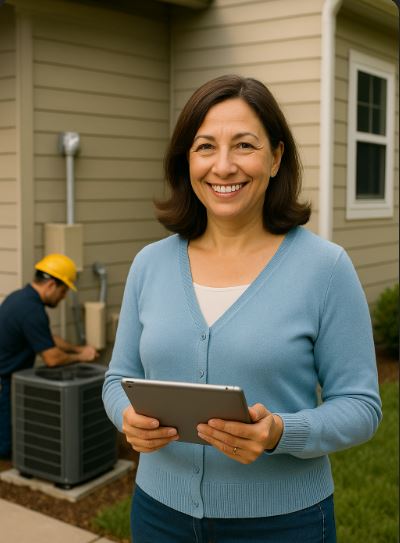👋 Hey there, Smart Homeowner!
It’s Samantha here—your go-to guide for making HVAC upgrades simple, savvy, and stress-free. If you're looking at one of The Furnace Outlet’s R-32 air conditioner and air handler systems, you’re already ahead of the curve. 💡
These systems are not only energy-efficient and environmentally friendlier, but they also give you the flexibility to DIY your installation if you're handy—or at the very least understand what your HVAC tech is doing when they install it for you.
🔧 Step 1: Prepping for Installation
Before anyone grabs a wrench or powers up a drill, you’ll want to get your ducks in a row. Here’s what to think through:
-
Space & Clearance: Your outdoor condenser needs room to breathe—at least 12" from the wall and 60" of vertical clearance.
-
Power Supply: Confirm that your breaker box has enough capacity (typically 208/230V for residential R-32 systems).
-
Drainage & Slope: The air handler should be installed with a slight pitch to ensure proper drainage.
📝 According to the U.S. Department of Energy, correct positioning and sizing of your HVAC system can increase efficiency by up to 30%. Don't underestimate the prep stage!
🧰 Step 2: Installing the System
Installing your system is a vital step in ensuring the system's efficiency and long life! Let’s walk through the major components:
🔲 Mounting the Condenser (Outdoor Unit)
-
Use vibration-absorbing pads or brackets.
-
Make sure the unit is level and away from direct debris flow (like falling leaves or water runoff from your roof).
💨 Connecting the Air Handler (Indoor Unit)
-
Position the unit where airflow won’t be blocked by furniture or curtains.
-
Install refrigerant lines with a gentle slope. R-32 is a mildly flammable A2L refrigerant, so leak-tight brazing is essential. (Your tech should be R-32 certified!)
🚨 Heads up: Per ASHRAE guidelines, R-32 systems must be charged precisely and leak-checked meticulously. Overcharging or undercharging can lead to performance issues—or worse, unsafe conditions.
⚡ Electrical Work
-
Follow your manufacturer’s wiring diagram. Most systems include a terminal strip that connects to your thermostat, power, and optional heat strips.
-
Ground all components properly to avoid shorts.
🛠️ Step 3: Troubleshooting Common Issues
Even with a great install, occasional hiccups happen. Here's what to check if something's not working quite right:
❄️ Problem: The system isn’t cooling.
-
Smart Check: Is the thermostat set to “Cool”? Is your air filter clogged?
-
Tech Tip: R-32 systems require specific charge levels. A low refrigerant charge often means a leak—don’t just “top it off.”
⚡ Problem: Breakers keep tripping.
-
Smart Check: Inspect for loose wires, undersized breakers, or signs of water near terminals.
-
Pro Move: An electrician can confirm proper breaker sizing, especially if you upgraded from an older R-22 unit.
💨 Problem: Weak airflow from vents.
-
Smart Check: Double-check your return air path. If it’s obstructed, your blower can’t do its job.
-
DIY Fix: Clean or replace the air filter, and clear vents from rugs or furniture.
🛠️ Step 4: Preventative Maintenance
Want to avoid surprise breakdowns and extend your system's lifespan? Here's your go-to routine:
-
🗓️ Replace filters every 1–3 months – a clean filter boosts airflow and protects both indoor coils and blowers.
-
🧼 Clean your indoor coil annually to maintain heat exchange efficiency.
-
🚰 Inspect and flush condensate drain lines each season to prevent backups and water damage.
-
📏 Check thermostat calibration each season to ensure the system operates at the right settings.
💡 Smart boost idea: Adding a smart thermostat that’s ENERGY STAR® certified brings automated savings, remote control, and occupancy sensing—all while helping lower your heating and cooling costs by around 8% annually. Plus, many utilities offer rebates for them, making the upgrade even sweeter.
🌐 Authoritative Resources for Deeper Learning
Whenever I’m looking to double-check facts or dive deeper into how HVAC systems work, I trust these authoritative sources:
-
If you’re curious about R‑32’s safety credentials, check out ASHRAE's official Refrigerant Designations and Safety Classifications. It explains how refrigerants are assigned flammability and toxicity ratings—why R‑32 falls into the A2L category—and what that means for installation and maintenance
-
For hands-on troubleshooting help, HVAC.com’s AC Troubleshooting Guide breaks down common performance problems—like warm air, weak airflow, and noisy operation—with step-by-step diagnostics for homeowners like us
💬 Final Thoughts from Samantha
You don’t need to be a licensed HVAC tech to make smart decisions. With the right tools, trustworthy resources, and a little help from The Furnace Outlet, you’ve got this! 💪
Ready to get started? Browse R-32 AC + Air Handler Systems here and take that next smart step toward cleaner, cooler comfort. ❄️🌿
Stay Breezy,
- Samantha, Home Comfort Advisor







